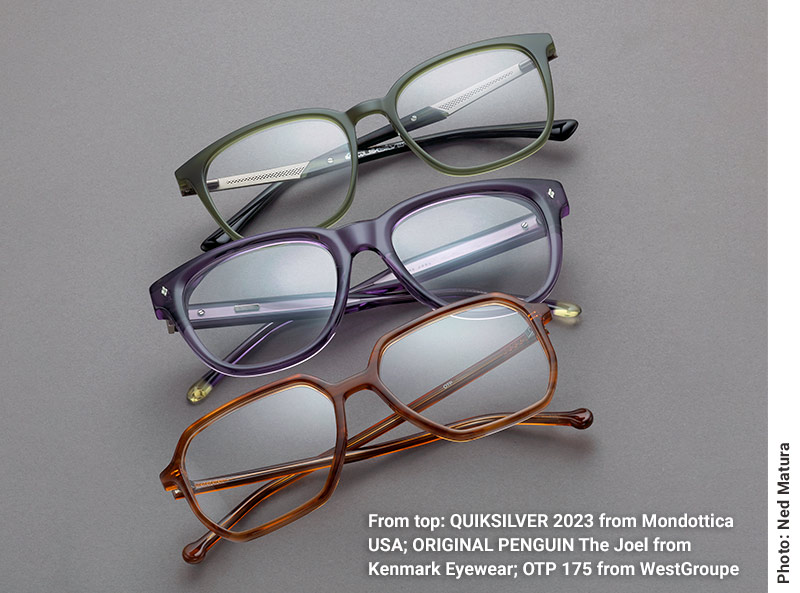
By Linda Conlin

The stereotype of the male eyewear shopper is that he is looking only for vision and comfort. Style doesn’t seem to impress him, and he’s very cost conscious. If that is your impression, then it’s time to give men and their eyewear another look.
Men’s eyewear has come a long way in these past few years. Suspect quality is no longer tolerated by men seeking spectacles up to the refined standards and tastes of today’s modern demands. Men are looking for distinctive shapes steeped in classic frame traditions but with novel twists on legendary themes. Color has dawned anew beyond the standards of black, gray, brown and tortoise.
Comfort and fit certainly are high on men’s priority list for eyewear, and they have to be durable. Men want larger, lighter styles to fit their faces, and they’re willing to spend outside of their insurance benefits to get them. Acetate frames in navy, crystal, green and more, can give them a sense of style, and combination frames can combine color with the look of metal. Some men might want to step out of the box when it comes to selecting eyewear. Be sure your dispensary includes frames with mixed materials such as wood or carbon fiber and frames in brighter, bolder colors for a more unique style.
Tip: The best frame for your male patient will be a perfect balance of size, weight and durability. Titanium, stainless steel and acetate frames check those boxes, all with new color choices.
Virtually every industry is looking to court the buying power of Millennials, no less with the eyewear industry. Millennials are less likely to buy something because of the brand’s name and more likely to buy something because of the brand’s story. They want that story to include giving back to a cause and sustainability. Millennials also want styles that reflect their individuality with color, shape and customization, albeit with validation from friends and social media. They are also more likely than other generations to say they feel attractive and cool when they put on their glasses.
Similar to Millennials, Gen Z prefers to express their personal style through bold, unique and often unconventional fashion choices. When it comes to eyewear, Gen Z values functionality just as much as style and prefers glasses that are made from sustainable materials and are ethically produced. In contrast to Millennials, however, Gen Z prefers bold and unconventional styles, while Millennials favor minimalist and timeless designs. Millennials tend to prefer classic designs such as round or rectangular frames, while Gen Z prefers more unique shapes such as hexagonal or CatEye frames (yes, there are CatEye styles for men). Millennials also tend to choose neutral, earthy colors such as black and tortoiseshell, while Gen Z is more likely to opt for bright and bold colors such as blue and green.
Tip: Give your men’s eyewear selection multigenerational appeal by including a variety of shapes and colors that are sustainably made. And don’t forget the brand story!
Don’t count out Boomers’ interest in style, as well as fit and function. Many Boomers are in their mid-60s, still going out for fun and living full lives. This demographic doesn’t view aging as a constraint on their ability to pursue things that make them happy, and they don’t want their father’s glasses. To look younger and more modern, frame shapes that lift the face, such as upswept rectangles in colors like gunmetal, deep browns and burgundy are good choices. What’s more, compared to Gen X and Millennials, Boomers are less concerned with cost.
Tip: Don’t allow preconceptions about age and price affect the eyewear selection process for Boomers. They want to connect with modern styles, and they control 70 percent of the disposable income in the U.S. (Gitnux Marketdata Report 2024)
Regardless of age, men are well aware that glasses can improve or transform their appearance. Glasses can draw attention to the eyes, add balance to facial features and create an air of sophistication or intellectual charm. The key is to choose a style that complements their natural features. Eyeglasses reveal self-image, involve personal relationships, reflect the opinions of professionals and affect the health of our eyes. The purchasing decision is further complicated by the fact that most people rely on glasses for a large portion of their day. Remember that style, recommendations by eyecare professionals and the opinion of people such as a spouse or other significant individual all impact choice and buying decisions across generations, with eyecare professionals having the greatest influence.












